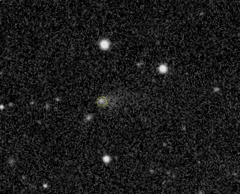76P/West–Kohoutek–Ikemura
Periodic comet From Wikipedia, the free encyclopedia
76P/West–Kohoutek–Ikemura is a Jupiter-family periodic comet in the Solar System with a current orbital period of 6.47 years.[2]
 76P/W–K–I photographed from the Zwicky Transient Facility on 29 December 2019 | |
| Discovery | |
|---|---|
| Discovered by | Richard M. West Lubos Kohoutek Toshihiko Ikemura |
| Discovery site | Geneva, Switzerland Hamburg, Germany Shinshiro, Japan |
| Discovery date | January–March 1975 |
| Designations | |
| P/1975 D1 P/1980 V2 | |
| |
| Orbital characteristics[1][2] | |
| Epoch | 21 January 2022 (JD 2459600.5) |
| Observation arc | 48.44 years |
| Earliest precovery date | 15 October 1974 |
| Number of observations | 1,281 |
| Aphelion | 5.341 AU |
| Perihelion | 1.603 AU |
| Semi-major axis | 3.472 AU |
| Eccentricity | 0.53829 |
| Orbital period | 6.469 years |
| Inclination | 30.466° |
| 84.109° | |
| Argument of periapsis | 359.95° |
| Mean anomaly | 124.62° |
| Last perihelion | 26 October 2019 |
| Next perihelion | 13 April 2026 |
| TJupiter | 2.685 |
| Earth MOID | 0.617 AU |
| Jupiter MOID | 0.049 AU |
| Physical characteristics[1][3] | |
| Dimensions | 0.62 km (0.39 mi) |
| 6.6±1.0 hours | |
| Comet total magnitude (M1) | 15.4 |
| Comet nuclear magnitude (M2) | 17.2 |
Discovery and observations
The comet was initially spotted on a photographic plate by Richard M. West at the European Southern Observatory Sky Atlas Laboratory, Geneva in January 1975, when it had a brightness of magnitude 12.[4] Inability to predict its movement from a single image meant the comet had to be presumed lost.
In late February it was accidentally rediscovered by Lubos Kohoutek at the Hamburg Observatory, Germany and independently on 1 March by Toshihiko Ikemura in Shinshiro, Japan. After further observations the comets parabolic orbit was computed, which gave a perihelion date of 23 March 1975 and proved that all three sightings were of the same object, which was accordingly designated 76P/West–Kohoutek–Ikemura.
The comet has been observed at its successive returns in 1987, 1993, 2000, 2006 and 2013.
Orbit
Further calculations by Brian G. Marsden determined the comet's elliptical orbit[5] and revealed that it had passed only 0.012 AU (1.8 million km) from Jupiter on 22 March 1972.[4] This close approach had reduced its orbital frequency from some 30 years to the current 6.48 years and its perihelion distance from 4.78 AU to 1.60 AU.
Physical characteristics
Its nucleus is estimated to have an effective radius of 0.31 ± 0.01 kilometers and its rotational period is estimated to be 6.6±1.0 hours.[3]
See also
References
External links
Wikiwand - on
Seamless Wikipedia browsing. On steroids.
